by Dr. Anand Titus and Geeta N. Pereira
The Western Ghats, recognized world over as one among the 18 HOTSPOTS of the world, consist of some of the finest shade grown coffee plantations. Shade grown Indian coffee mountains stretch forth hundreds of miles and are known to harbor the widest variety of rare flora and fauna.
Few landscapes have such beautiful wildlife and biodiversity. The coffee mountain is brilliantly engineered to accommodate multiple systems. It is a marvel of adaptation. Inside the ecofriendly coffee farm, nature has elaborately evolved to accommodate diverse species of plant, animal and microbial life. The genetic future of these diverse species is secure because of the embedment of harmonious family groups. The degree of unity among and between biotic partners is amazingly high.
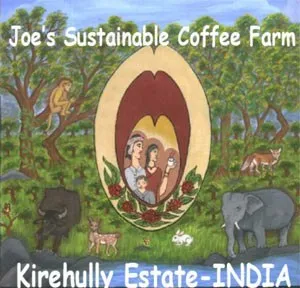
The microscopic analysis of the sacred coffee mountain reveals a unique ecology driven by a huge energy requirement. Energy is the single most essential requirement of all living things. The energy required is produced in most of the living systems by the oxidation of food with the help of oxygen. Food acts as a fuel which produces energy needed to carry out different activities.
The availability of energy in the desired form ultimately determines the survival of millions of bio diverse species inside the coffee mountain. From the coffee farmer’s perspective, the plantations are unique living laboratories providing vital links into the setting up of stable, complex food chains and food webs. Every organism inside the coffee mountain is part of this food chain. The present article throws light on the eco dynamic coffee cube [3] in nurturing the energy flows right into food chains and food webs.
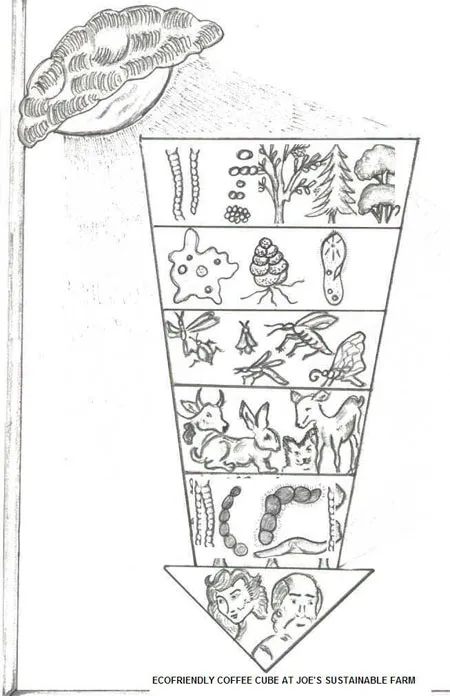
ENERGY BALANCE
The most crucial factor that affects the survival of the species; fall into one of two categories, namely those that affect the available food supply and those that affect the rate of destruction of individuals. The energy locked up in various substrates travels in a one way direction through the ecosystem but nutrients are constantly recycled. Inside the coffee mountain; due to the forest factor the energy balances are evenly distributed and aids in the live and let live approach. In the final analysis, each species plays a vital role in the biological food chain.
Due to the presence of leaf litter and highly decomposed organic matter on the floor of the coffee forest, microorganisms with their short generation time convert the unavailable complex nutrients into energy rich substances which can be easily assimilated by various species. Every step is characterized by energy transfers, leading to the availability of nutrients for the smooth functioning of the incoming species.
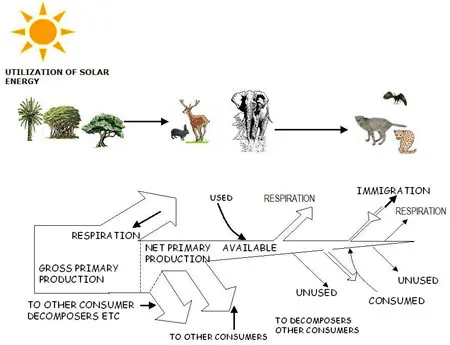
The major part of the coffee mountain is covered by a canopy of trees. Canopy photosynthesis converts light energy into chemical energy which in turn is gradually changed to heat energy. All chemical reactions taking place in the cell require a large ACTIVATION ENERGY to initiate various transformations. This chemical energy is especially useful to other forms of life which lack the pigment chlorophyll to manufacture their own food.
This chemical energy is the engine driving the metabolic processes within the microbial cell, enabling it to carry out various transformations. As a matter of rule, the same amount of energy that enters the system leaves it. Microbes use a part of this energy in respiration which in turn is dissipated as heat energy. This energy is lost forever. A few microbial communities derive energy from light through their photo chromatic pigments; others oxidize carbon monoxide to carbon dioxide, hydrogen to water and so on.
The chemical processes occurring in living organisms is termed metabolism. These metabolic reactions are synonymous with chemical reactions. In the coffee ecosystem (biological system) two kinds of metabolic activities occur. A) Consumption of energy from within the coffee mountain. B) Utilization of energy in the formation of the biological entity. The multitudes of biological systems within the confines of the coffee mountain live a highly organized and structured life with the help of a complicated energy balance.
Food translates into energy and more energy consumes more food and the cycle repeats. Various factors affect the available food supply of a species. The availability determines the population dynamics. If a proper balance is not maintained then an excessively large population may in turn exhaust the food supply resulting in the shortage of food for the subsequent generation. Ultimately, it affects the population of that particular species.
FORMS OF ENERGY
Energy exists in a number of forms, like light, electrical, mechanical, heat, chemical and others. Mechanical energy is employed for cellular movement of microorganisms. Electrical energy is produced as a part of cellular activity in detecting the tiny electrical fields in and around the coffee landscape. Electromagnetic energy occurs in the form of radiations. Some bioluminescent bacteria produce light energy.
Chemical energy is the energy that can be released from organic or inorganic compounds by chemical reactions. Any biological system can make use of chemical, electrical and light energy. However, a large majority of the energy reactions occurring within the coffee mountain are based on chemical energy. All biological systems produce heat as a part of their normal energy transformation. Living organisms cannot use heat as a primary energy source. Hence, energy released by an organism as heat gets wasted.
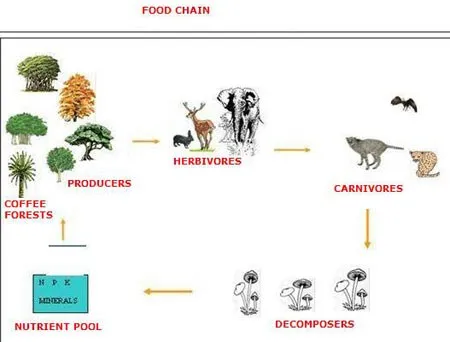
Energy is being continuously transformed from one form to another. Whenever one form of energy disappears, another form appears in an equivalent amount, so that the total amount of energy within the coffee mountain is always the same. Direct, indirect and even delicate relationships exist between the various components of the coffee ecosystem. The coffee mountain is thus organized into a large number of intersecting food chains and food webs.
Energy transformations in physical and chemical processes are usually accompanied by a transfer of heat to or from the surroundings. Those that occur with the release of heat are termed EXOTHERMIC (Burning of wood) and those that involve the absorption of heat from the surroundings are termed ENDOTHERMIC (Melting of ice).
UNDERSTANDING A FEW TERMINOLOGIES
BIOMES: A biome is made up of the total of all biological communities interacting within a single life zone where the climate is similar.
FOOD CHAINS & FOOD WEBS: The interactions that exist between producers and consumers inside the coffee ecosystem are referred to as food chains where in Autotrophs and heterotrophs are linked together by a simple linear relationship. Food chains are not isolated sequences but are interconnected with one another. These interlocking patterns (several food chains) that establish a network of species relationships constitute the food web.
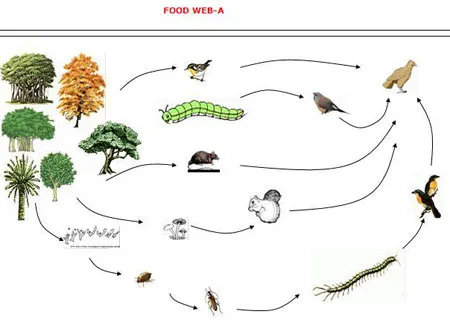
TROPHIC LEVEL: The various steps in the food chain at which transfer of food (energy) takes place.
FOOD LINK: The species which occupy each tropic level in the food chain forms a link.
DETRITIVORES: are organisms that feed on all kinds of dead plant and animal tissue.
ECO FRIENDLY SHADE COFFEE
One interesting point to be borne in mind is that India is one among the very few countries in the world growing coffee under a three tiered shade system. Indian coffee plantations act as hosts to a variety of evergreen trees. Different tree species (> 50 different species per acre) in addition to hundreds of herbs and shrubs regulate the sunlight from directly reaching the coffee bush. The filtered sunlight greatly influences canopy photosynthesis and reduces transpiration. Some trees shed forth narrow shaped leaves and some others, broad shaped leaves in an irregular fashion which forms a thick layer of mulch on the floor of the forest. This mulch obstructs sunlight from reaching the forest floor resulting in the differential energy levels at various tropic levels.
The autotrophic component fixes solar energy by photosynthesis. Light energy is converted into chemical energy in the form of organic compounds. The first tropic level consists of green plants which act as producers. They are the corner stone of the food chain. The second tropic level consists of herbivores (primary consumers); the third tropic level consists of carnivores (secondary consumers) and the fourth tropic level consists of secondary carnivores (man). (The first order consumers are the herbivores (insects), the second order consumers are the Primary carnivores, the third order consumers are the secondary carnivores and the fourth order consumers are the tertiary carnivores.
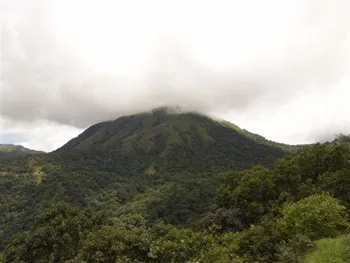
SIGNIFICANCE OF BIOMASS ACCUMULATION
According to the scientists at the Coffee Research Institute, Balehanoor, shade trees inside the coffee forest contribute roughly 10 x 10 [3] kg of leaf litter/ha/year. In coffee farms where Erythrina (Dadap) acts as a temporary or permanent shade, the annual return of nutrients is around 96 kg nitrogen, 8 kg phosphorus and 67 kg’s potash in the form of degradable stakes, tender branches and leaves. It is estimated the coffee bush also periodically sheds its leaves.
There is a tremendous amount of nutrient energy stored in this biodegradable biomass. Various biotic partners like lichens, mushrooms, bacteria and actinomycetes take turns in natures clean up resulting in the FREE FLOW of energy. Bacteria, fungi and other microorganisms consume fully 95 % of the vegetation in the soil. The significance of this is that ECOFRIENDLY coffee farms are self sustainable, recycling precious bio wastes due to the organic matter decomposition by billions of microorganisms. This prevents soil erosion and pollution of water bodies.
COMPONENTS OF THE COFFEE ECOSYSTEM
The coffee ecosphere consists of all living things, all inorganic materials and physical forces interacting with one another. Understanding the coffee ecosphere aids in unraveling the energy flows, deciphering the interactions between living things and the environment, the transfer of food, the flow of energy and the exchange of inorganic nutrients and organic compounds. The coffee grid in turn depends upon the delicate balance of ecological processes for the fulfillment of its needs.
The coffee ecosystem closely interacts with the BIOTIC (LIVING) & the ABIOTIC (NON-LIVING) environment. The relationships between the different factors are so smooth and often so subtle that seldom we are aware of the immense structural and functional complexities involved. Within the coffee mountain there is a great diversity in the types of ecosystems because of the change in elevation within a single zone. The energy balance within each system, ultimately determines the health of the coffee forest.
The dominant energy which enters the coffee ecosystem is mainly in the form of sunlight and is used by photosynthetic organisms in the synthesis of organic matter. The energy and the nutrients obtained from the nutrient pool of the soil move from producers to herbivores. A part of this energy is dissipated by the organisms during respiration and the rest made available to herbivores, which are animals that consume the photosynthesizers. The herbivores in turn make use of this energy in the build up of cellular constituents and make way for the carnivores. The carnivores use the herbivores as their primary energy source and the food chain continues with one carnivore eating the other.
It is of paramount importance to remember that every step is characterized by a chain of events leading to energy loss in the form of heat. Death or destruction of flora or fauna results in the establishment of DECOMPOSERS. The decomposers act on the litter, decaying plants and animals and return the minerals to the nutrient pool. The primary decomposers are the microorganisms. Microorganisms utilize energy released by plants and animals in the form of excretory products.
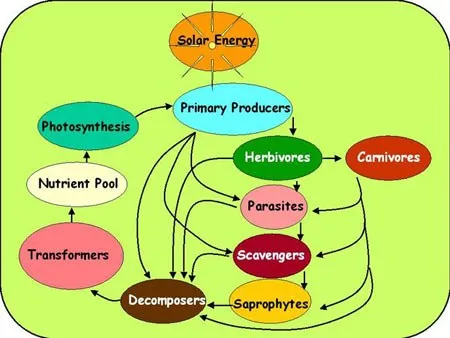
BIOTIC COMPONENTS: Producers, Consumers, Decomposers
ABIOTIC COMPONENTS: ENVIRONMENT, INORGANIC ELEMENTS, CARBON, OXYGEN, HYDROGEN, WATER, POSPHATES, CARBONATES Minerals, Liquids, Gases, PHYSICAL FACTORS-MOISTURE, AIR CURRENTS, LIGHT.ETC. ORGANIC: Proteins, Carbohydrates, lipids, etc.
MACROCONSUMERS OR PHAGOTROPHS: Heterotrophic organisms mainly animals. Organisms which obtain their energy from sources other than themselves, indirectly or directly.MICROCONSUMERS: Chiefly Bacteria, fungi. Actinomycetes.They break complex organic molecules into simpler compounds for producers.
PRODUCERS OR AUTOTROPHS: These are the green plants with the help of chlorophyll prepare their own food. Since, green plants or producers convert solar energy into chemical energy, they are sometimes referred to as transducers of energy.
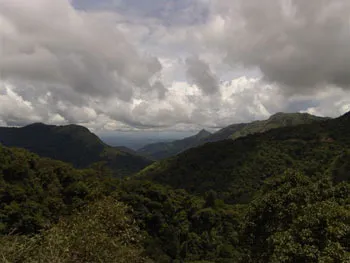
CONSUMERS
The physical and chemical environment inside the coffee mountain plays an important role in the distribution of energy levels. Within the boundaries of the coffee mountain biotic partners interact and carry out their activities significantly modifying the characteristics of the mountain.
Only a small fraction of the solar energy (< 10% of the total solar energy falling upon the coffee forest is used by the first tropic level. This chemical energy stored in the plant tissues is used up by the plant to carry out its physiological activities and a part of the energy is transferred to the next tropic level, namely consumers, also referred to as HETEROTROPHS. Along the transformation path, there is a loss of certain amount of energy. Further, the flow of energy is always unidirectional and gradually tapers. Useful energy level steadily declines from one tropic level to the other.
ECOLOGICAL PYRAMID
An inside view of the coffee mountain reveals a highly organized and intelligent ecological pyramid. First come the producers (Tall evergreen trees, herbs, shrubs, climbers,) and then a regular decrease in the energy, biomass and number of organisms occupying a tropic level. The pyramid starts with a broad base and ends tapering at the apex.
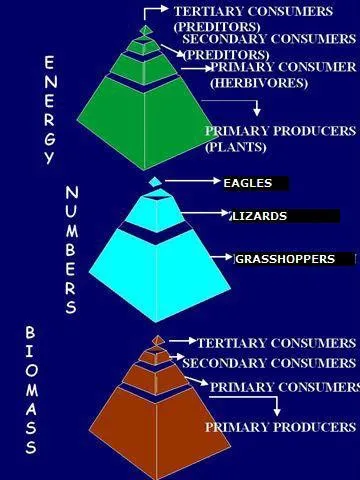
- PYRAMID OF NUMBERS: It indicates the numerical relationship between the different tropic levels of the food chain.
- PYRAMID OF ENERGY: Explains the movement of energy flow at each tropic level as well as the role played by different organisms in the transfer of energy. Energy pyramids are always slopping. Greater amount of energy is available at the producer level and gradually decreases by the time it reaches the primary consumer level. In turn Energy production of the primary consumers is greater than that of the secondary consumers.
- PYRAMID OF BIOMASS: Represents the total dry matter present in the ecosystem at any one given point of time.
The energy sources within the coffee mountain are highly variable depending on the seasons. Some nutrients are available only for short periods of time because of the rapid colonization and consumption of microorganisms and in some cases depending on the leaf shedding there is an excess of nutrients on the floor of the forest.
The best part of the energy equation is that microorganisms have evolved highly sophisticated regulatory mechanisms to make use of the available energy resources. This has a tremendous bearing on the quantitative yield and qualitative yield of coffee.
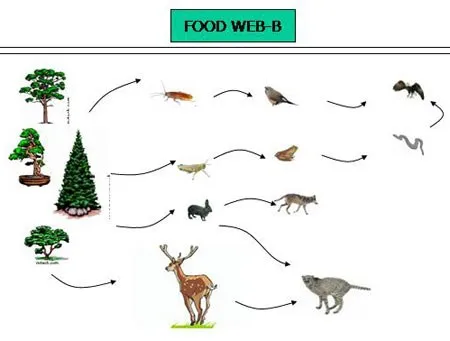
Depending on the elevation, rainfall, temperature and other related physical factors the coffee mountain is organized into a large number of intersecting food WEBS. This complex food web consists of diverse number of species, the populations of which have reached equilibrium in terms of rate of multiplication and destruction. Any sudden or drastic change in equilibrium results in the break down of the natural rhythm of the ecosystems.
JOE’S SUSTAINABLE FORMULA: THE KIREHULLY EXPERIMENT
Based on our very own experiments as well as collecting data from fellow farmers we have arrived at a few significant conclusions which will help coffee farmer’s world wide in maintaining the productivity and a sound ecological balance within their coffee farm.
Productivity is generally defined in terms of the amount of dry matter accumulated within a specified period, expressed in grams/m?/day. The productivity of green plants is known as primary productivity and that of consumers and decomposers as secondary productivity.
GROSS PRODUCTIVITY: It is a reflection of the sum total of organic compounds accumulated, inclusive of the amount used in respiration by the plants during which measurements are made.
NET PRODUCTIVITY: Refers to the amount of organic compounds stored by the plants in their tissues.
- For every ton of raw coffee (Arabica) sold, the coffee farmer needs to externally add up to two tons of compost. In case of Robusta coffee, the required compost is one and a half tons.
- For every ton of anticipated coffee, two and a half tons of compost should be added in the available form.
- The raw materials used for compost should have a low carbon nitrogen ratio and it is preferable to use Sheep, poultry and cattle manure mixed along with raw neem seeds, coffee pulp and green leaves of erythrina indica and glyrecedia immaculate.
- Timing of application of compost is very important. Check other articles (Fine art of composting, organic manures).
- It is not advisable to only use cattle manure as a base for compost. Every compost pit should be lined with soil from fertile cradle pits or water trenches to boost the native micro flora.
- In case of ROBUSTA, with increase in age of plants, the application of nitrogenous fertilizers should be reduced.
HOMEOSTASIS: AND CYBERNETICS
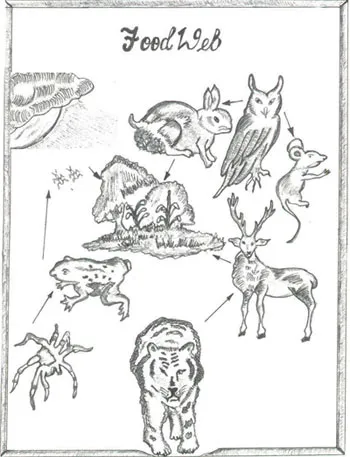
HOMEO=SAME, STASIS=STANDING. To a considerable extent, coffee ecosystems are self regulating entities that have a high degree of equilibrium or homeostasis. The environment and the organisms are both products of a continuous process of change.
Cybernetics refers to undesirable man made changes in trying to disturb the natural controls. For e.g. In spite of dramatic changes in the weather due to depleting forest cover or sudden rise in hydrogen ion concentration, due to excessive application of nitrate fertilizers, the coffee bush as well as the surrounding flora and fauna try to adjust their physiological activity by switching on and switching off a few essential genetic components so as to not be affected by the sudden change. However, if the changes persist over an extended period of time, then there is every likelihood in the collapse of the biotic system.
CONCLUSION
Evolutionary biologists have time and again arrived at one scientific truth that has great relevance for shade grown Indian coffee plantations. They are of the opinion that it is not necessarily the strongest or the largest species that survive, but the one’s most responsive to change.
However, it is to be observed that these changes should be gradual and a product of nature rather than man made, sudden and dramatic. When the changes are slow, it gives adequate time and ability for the biotic partners to adapt and transform to survive the changing times and thrive. Nature is an amazing survivor under such circumstances.
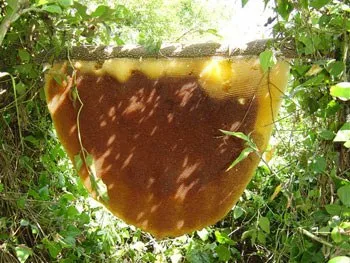
Managing coffee plantations has been a deeply enriching experience for the two of us. Our observations for the past 20 years point out that the coffee forests possess the most luxuriant vegetation of all biomes and there is a strong ASSOCIATIVE INFLUENCE among various biotic components inside the coffee mountain. The coffee ecosystem is mutually interconnected and interrelated.
A few factors like global warming, geochemical changes, destruction of forests, commercial logging, toxic levels of pesticide residues can drastically imbalance or upset the food supply chain resulting in the breakdown of food webs. The reason may be attributed to the fact that we have not been able to understand the delicate and orderly balance that exists in the natural ecosystems. One has to bear in mind that all food chains are cyclic in nature.
Tim Radford reports in the “GUARDIAN” under the title BLUE PLANET’S RED BALANCE SHEET that the human race is living beyond its means. A report backed by 1360 scientists from 95 countries-some of them world leaders in their fields warns that almost two thirds of the natural machinery that supports life on earth is being degraded by human pressure. The wetlands, forests, savannahs, estuaries, coastal fisheries and other habitats that recycle air, water and nutrients for all living creatures are being irretrievably damaged. In effect, one species is now a hazard to the other 10 million or so on the planet, and to itself.
Human activity is putting such a strain on the natural functions of earth that the ability of the planet’s ecosystems to sustain future generations can no longer be taken for granted. The report prepared in Washington under the supervision of a board chaired by Robert Watson, the British born chief scientist at the world bank and a former scientific adviser to the White house, will be launched soon at the Royal Society in London. It warns that because of human demand for food, fresh water, timber, fiber and fuel, more land has been claimed for agriculture in the last 60 years than in the 18th and 19th centuries combined. An estimated 24% of the earth’s land surface is now cultivated.
One burning question that remains in our mind is that at the present rate of destruction whether coffee mountains will remain without biodiversity? Coffee farmer’s world wide should be cautious in destroying forest relationships.
In the new world order, the temptation of using chemicals and pesticides is even greater. This practice can contaminate food webs. At each level of the food chain, chemicals and heavy metals can go on concentrating and finally get embedded in the human body as a result of BIOMAGNIFICATION. This can result in dire consequences for future generations. The ultimate aim of technology should be in preserving nature.
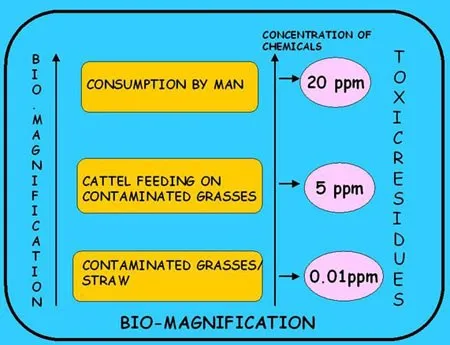
Everything that man has made in this world is surpassed by nature. We need to focus on the small details in order to better appreciate the larger spectrum. This will enable us to be conscience to the many dimensions of our existence and treat the resources of the mountain with respect. A sustainable system empowers coffee farmers to build better lives. It is our obligation to understand that in nature’s shadow we all co exist.
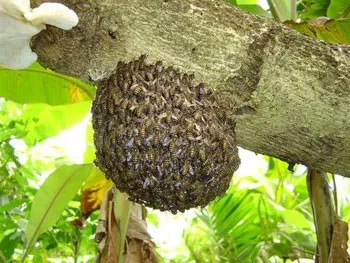
ACKNOWLEDGEMENT
The authors wish to express their profound gratitude to Mr. Allen J Pais, Coffee Planter, “PROVIDENCE ESTATE”, Siddapur, Coorg, Kodagu for his incredible support in our pursuit of all things good. We are also grateful for his steadfast commitment and unflagging guidance in designing the banner (JOE’S SUSTAINABLE FARM).
We would also like to thank Allen for his invaluable work in conceptualizing and drawing the food chains and food webs.
REFERENCES
Coffee Plantations A Multidisciplinary Approach
Organic Matter Decomposition In Coffee Plantations
The Fine Art of Composting In Coffee Plantations
Significance of Lime Application in Coffee Plantations
Global Warming in Coffee Plantations
Biodiversity In Relation To Coffee Plantations
Role of Bacteria in Coffee Plantation Ecology
Role of Fungi in Coffee Plantation Ecology
The Role of Actinomycetes in Coffee Plantation Ecology
Role of Ectomycorrhizae In Coffee Plantations
Significance of Microbial Interactions Within Coffee Plantations
Alexander, M. 1974. Microbial Ecology. New York. John Wiley and sons.
Alexander, M. 1977. Introduction to soil Microbiology. 2nd edition. New York. John Wiley and sons.
Atlas, R.M. and R. Bartha. 1993. Microbial Ecology: Fundamentals and application. Third edition. Benjamin/Cummings Pub. Co. New York.
Brock. T. D. 1979. Biology of Microorganisms. Third Edition. Englewood Cliffs. Prentice-Hall.
Coffee Guide. 2000. Central Coffee Research Institute, Coffee Research Station. Chikmagalur District. Karnataka. India.
De Witt. W. 1977. Biology of the cell. An Evolutionary Approach. W.B. Saunders Company. Philadelphia, London, Toronto. .
Davis. B.D; R. Dulbecco; H.N. Eisen and H.S.Ginsberg. (1980). Microbiology. Third Edition. New York. Harper and Row.
Hans. G. Schlegel. 1988. General Microbiology. Sixth Edition. Cambridge University Press. Cambridge.
Goldsby. R. A.1979. Biology. Second Edition. Harper and Row publishers Inc.
Kelly. D. P. 1978. Microbial Ecology. In K.W.A. Chater and H.J. Somerville (Eds). The oil industry and microbial ecosystems. Heyden and Son, London.
Tilman. D. 1982. Resource Competition and Community Structure. Princeton University Press, Princeton, NJ.
Kotpal, R.L. and N.P. Bali. 2003. Concepts of Ecology. : Environmental and field biology. Vishal Publishing Company, India.
Killham. K. 1994. Soil Ecology. Cambridge University Press, Cambridge. England.
M.B.V. Roberts. 1979. Biology. A Functional Approach. Students Manual. The English Language Book Society and Nelson.
Odum.E.P. 1971. Fundamentals of ecology. Third edition. W.B.Saunders company. Philadelphia.
Paul Singleton and Diana Sainsbury. 1981. Dictionary of Microbiology. WIE Edition April 1981.
Rangaswami . G and Bagyaraj, D. J. 2001. Agricultural Microbiology. Second edition. Prentice-Hall of India Private Limited. New Delhi.
Subba Rao. N.S. 2002. Soil Microbiology (fourth edition of soil microorganisms and plant growth) Oxford and IBH Publishing CO. PVT. LTD. New Delhi.
Schultz. A.M. 1971. Ecosystems and environments. Canfield press ( Harper and Row ), San Francisco.
Wolfe, S.L. 1972. Biology of the Cell. Wadsworth Publishing Company. Inc., Belmont. California.